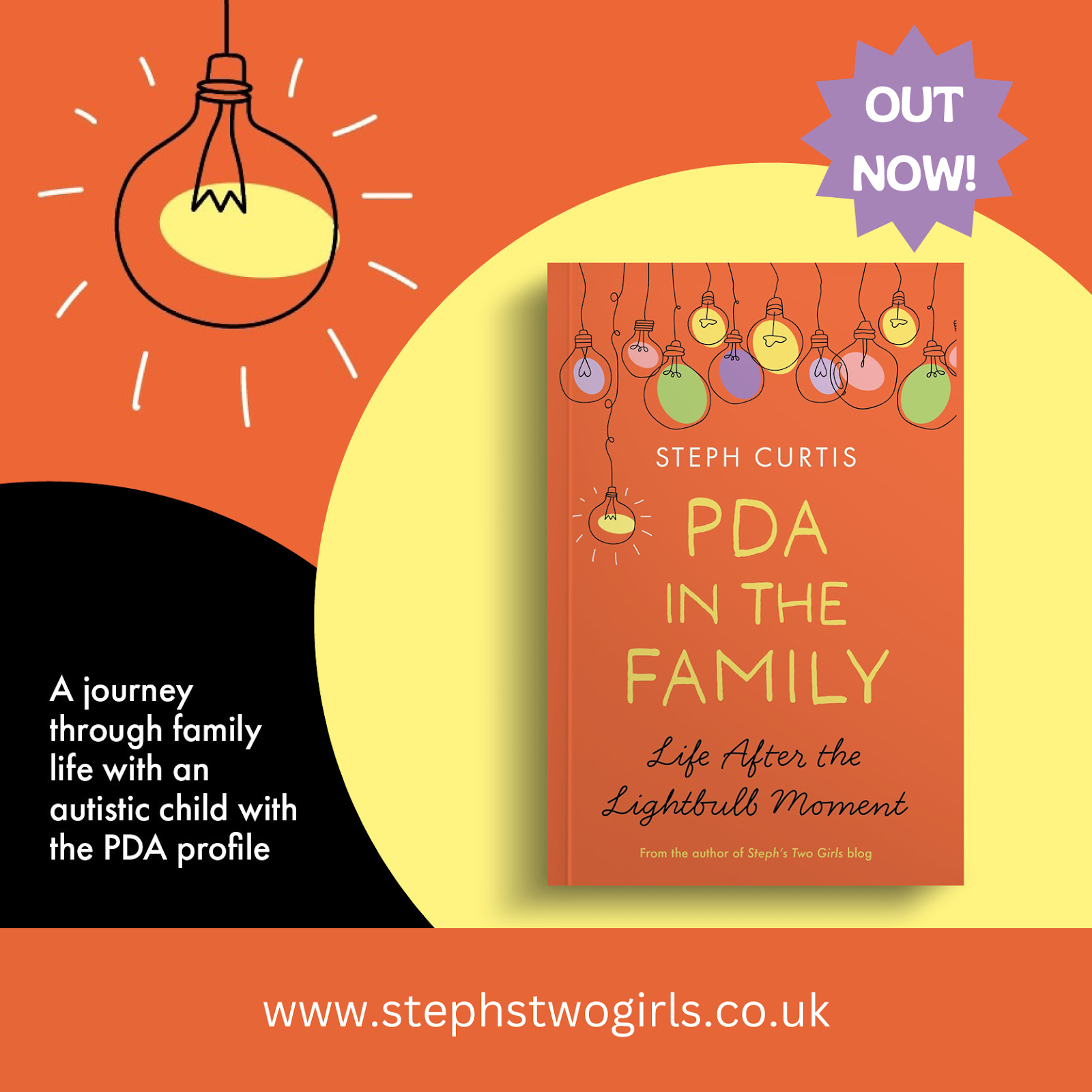This week's story is from a lady who really has been there and done that - actually still doing it - when it comes to PDA. As you'll see, her daughter was diagnosed at seven, and is now 11. The family has been through some tough times since then, but thanks to using the correct PDA strategies they are coming out the other side. Jane has written a book about her experiences, which I know has been a great help to many other families dealing with PDA.
It's called My Daughter is NOT Naughty and even the title resonates loudly with me. You can check it out in more detail by clicking on the title.
Pathological Demand Avoidance – There is Light at the End of the Tunnel
My daughter first began to noticeably show extremely challenging behaviour at eighteen months of age. Biting, spitting, kicking and point blank refusing to do simple things like getting dressed, getting into the car, into her car seat or pushchair were just a few of the behaviours that we began to see. We were not unduly concerned and put this behaviour down to ‘the terrible twos’ which is, after all, a very typical developmental stage for many children. Despite the consistent and firm use of traditional behaviour modification nothing but nothing seemed to alleviate or to moderate these behaviours. Instead they became progressively worse and more and more pervasive throughout all aspects of her life.
By the time she was three I was struggling to cope with the constant meltdowns which, at that time, I just thought were childhood tantrums. Also she was becoming more and more resistant to any suggestions or demands at all, she was completely obsessed with me and would actively attempt to stop me, by using a variety of strategies, from having any type of communication with other members of the family. Her obsession with me became suffocating and she could not stand me speaking to her dad or her brother.
She was hyperactive, constantly on the go, needed one on one attention all of the time and never, ever played or entertained herself at all. I was exhausted but still thought that this was a phase that she would grow out of and eagerly awaited for her to begin school, feeling that this would be a pivotal moment where we would see a natural decrease of such challenging behaviours.
The beginning of nursery school, in a mainstream setting, when she was nearly four years old was indeed a pivotal moment but for all of the wrong reasons. Instead of behaviours becoming more manageable this is when they actually exploded beyond all control.
Between the ages of four and six Mollie would experience numerous meltdowns in school that would involve attacking staff and children both physically and verbally as well as the destruction of property and the trashing of classrooms. The school and I worked together to try to teach her age appropriate behaviour but nothing worked and the school and I were at a loss. During this period she was excluded on many occasions and eventually she was completely refusing to attend school regardless of rewards or consequences.
In year one everything went completely pear shaped and getting Mollie into school at all was proving to me more and more difficult. Sometimes it could even be 11am or noon before I managed to get her into school at all. Within a few short months we were experiencing complete school refusal.
At the age of six and following a hard fought for diagnosis of Asperger Syndrome I, with the full support of all the involved agencies, removed her from mainstream school in order to pursue a more specialised placement. She was out of school for fifteen months while a new placement was secured and funded. During this period life at home was unbearable and I was on the verge of completely cracking. Meltdowns involving physical violence, every room in the house being completely trashed and verbal abuse were occurring at least three times a day and the rest of the day was spent walking on egg shells trying to avoid or to diffuse any further outbursts.
None of the recommended strategies for Asperger’s worked with Mollie and we found ourselves in a downward spiral of behaviour. Also none of the extensive research that I was doing with regard to Asperger’s was providing me with any answers, the diagnosis just didn’t seem to accurately fit my child or to describe her difficulties. I decided to revisit a diagnosis that I had investigated at an early date called Pathological Demand Avoidance Syndrome.
This fitted her like a glove and at the age of seven she was diagnosed with PDA at the Elizabeth Newson Centre (ENC). I funded the assessment privately due to a complete lack of awareness, understanding or even acknowledgment of the existence of this condition from my local health authority.
Following Mollie’s diagnosis of PDA she was promptly discharged from all of my local health authority services and I was effectively blackballed. I am even aware that some psychiatrists refused to see Mollie, point blank, due to her diagnosis. Unfortunately I was left to navigate this complex condition without a map or compass due to the actions of my local health authority and the victim in all of this was, at that time, a seven year old child!
Her second school placement were wonderful and everything was implemented to PDA perfection but still Mollie could not cope and the behaviour, despite the use of PDA strategies, did not yield any long term results. After about eight months she was again having multiple meltdowns at school and behaviour at home, while not as violent, was still as challenging. This fear of public meltdowns in school eventually led to school refusal.
Her final school placement was at a specialised ASC placement but again this eventually resulted in her extremely high anxiety resulting in school refusal. It was at this stage that I realised and accepted that the only place that Mollie could cope was at home and so I made the decision to completely remove her from mainstream education and to home educated her following a philosophy of unschooling.
During the last two years we have made fantastic progress with Mollie and our family is a much happier and calmer place for all of us. Violent meltdowns are now nil and we have only experienced one meltdown in the last two years that has involved the destruction of property. As Mollie is growing older and maturing she is learning naturally from play and the world around her.
Following a period of over a year of being unable to even the leave the house due to social anxiety she is now venturing out more as and when she can achieve this. Her ability to moderate her own behaviour in accordance with the needs of others is also greatly improving and she will often apologise following a verbal outburst. She is also now able to mix more successfully in group situations within the family without needing to dominate and control all social interactions.
This progress has taken two years for us to reach where we are today. Progress can be painfully slow and it is only when one looks back that you can sometimes actually see just how far you have come. For us progress required the removal of school, due to her extremely high social anxiety, combined with the continual use of PDA strategies as well as developing successful techniques for other areas of difficulty.
We had to adapt our world to fit in with her version of what is normal rather than expect her to change and to adapt to a world that may be our version of normal but was ‘hell on Earth’ for her. What is normal, it isn’t a fixed concept but is variable depending on the individual. Mollie now has a life and an environment that is ‘her normal’. As time goes on we hope that she can manage to mix in the frantic and unpredictable neurotypical world for longer periods of time so that the balance between isolation and socialising becomes a little bit more even.
For now life is good and we have reached a place where I never thought this family would be, we are a happy and well-functioning family unit. Our way of living is radical, unorthodox and unique but it is what works for us and it is how we have managed to find a life worth living again for all of us.
Below is a link to the basic strategies that we used and continue to do so on a daily basis.
PDA strategies
---------------------------------------------------------------------------------------------------
To find out more about our experiences, please check out our 'About Us' page. If you are looking or more information on Pathological Demand Avoidance, why not try some of these, my most popular posts?
What is PDA (Pathological Demand Avoidance)?
Ten things you need to know about Pathological Demand Avoidance
Does my child have Pathological Demand Avoidance?
The difference between PDA and ODD
Strategies for PDA (Pathological Demand Avoidance)
Pathological Demand Avoidance: Strategies for Schools
Challenging Behaviour and PDA
Is Pathological Demand Avoidance real?
To follow me on other social media channels, you can find me at the following links or click the icons below!
Facebook: www.facebook.com/stephstwogirls
Twitter: twitter.com/stephstwogirls
YouTube: www.youtube.com/c/stephcurtis
Instagram: www.instagram.com/stephstwogirls/



















